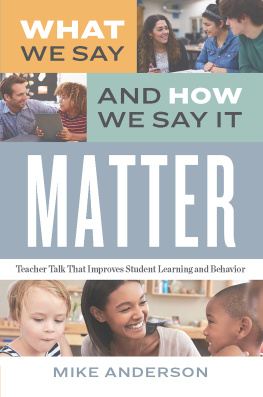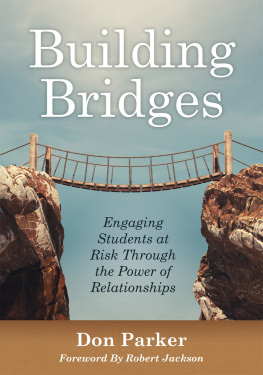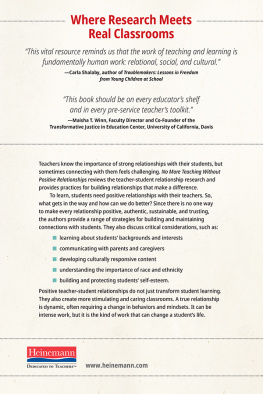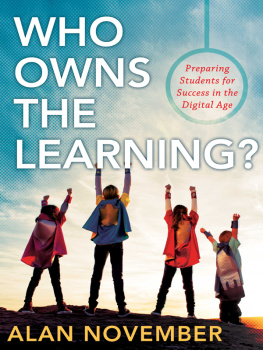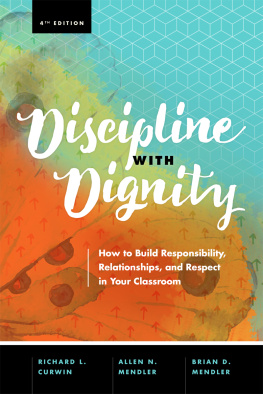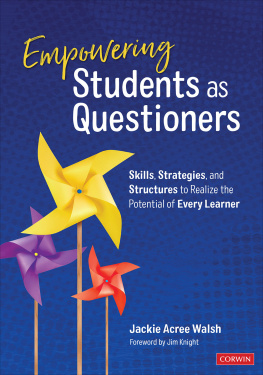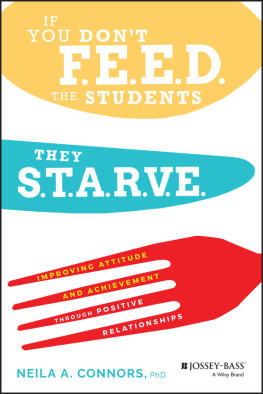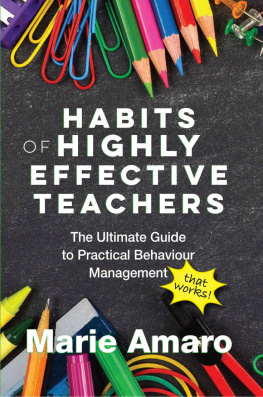Contents
Guide
Pages
Acknowledgments
....................
I'd like to begin these acknowledgments by recognizing some of the most important thought leaders who have shaped my thinking about language in the classroom (and beyond) over the years. Peter Johnston, Jane Nelson, Alfie Kohn, and Ross Greeneyour work has inspired and pushed me, like so many other educators. Your experience with children and your insights into teaching and the language of the classroom have been powerful influences on my evolution as a teacher. I'd also like to especially thank Ruth Charney, Marlynn Clayton, and Paula Denton, whose writing, collegiality, professionalism, coaching, mentorship, and friendship directly shaped who I am and how I think about teaching and language.
There are lots of people who had a substantial impact on the writing of this book. Many teachers in many schools helped me think deeply about how language affects learning, including Barbara Milliken, Chris Hall, Kitri Doherty, Lindsay Lanzer, and Ian Fleischer. I'd like to thank colleagues Kathy Collins, Allison Zmuda, Bena Kallick, Carol Davis, and Kristen Vincent. Your encouragement, support, and many conversations about ideas in this book have made it more complete. My mother, Susan Trask, my wife, Heather Anderson, and my two children, Carly and Ethan, have also been hugely helpful and supportive, enduring (and even enjoying, I hope) the many conversations we've had about this topic. Even our dog, Olive, had a role to playlistening without commenting and offering me chances to walk and clear my head when the writing got tough. There were also several people who read drafts of parts of this manuscript as it was in-process: Shawna Coppola, Andy Dousis, Holly Martin, and my father, Marion Anderson. Your direct and honest feedback was invaluable and much appreciated!
Finally, a special shout-out goes to Genny Ostertag and Liz Wegner, ASCD editors extraordinaire, who helped bring this book to life (and make it a whole lot better in the process). Thanks so much to you and the whole ASCD team!
Chapter 1
What We Say and How We Say It Matter
....................
This is a book about language. More specifically, it's a book about language habits and patternsthe habits and patterns that we use all day and every day in our work with students. We must rely on habits and patterns when it comes to language, for in the midst of all that teachers must do (think ahead about the next step of the activity, keep an eye on the back table of students who seem to be getting off track, keep our other eye on the clock, get reoriented after an announcement blares over the intercom, wonder briefly about the parent who sent an e-mail earlier in the day, notice that three hands just shot up as students seem to be getting confusedand this all in the blink of an eye), there's no way we can consciously think about everything we say before we say it.
Even more specifically, it's a book about the intersection of our language patterns and our best intentions. After all, don't we all have positive intentions and goals for our students? We all want our students to be passionate about learning, to engage in prosocial interactions, to behave positively and appropriately throughout the dayand to do so for the right reasons. For all the discussions and varying opinions about pedagogy in education today, I find that most educators have many of these core values in common. We all want what's best for our students. And yet
We all end up in language patterns that don't match our best intentions. We may even fall into habits that run in direct opposition to what we know is best for our students. Let me illustrate with a story.
At the end of my first year of teaching, I wanted some feedback from my 4th graders, so I created a report card for students to fill out for me and encouraged them to give me honest feedback. It was roughly modeled after the report card our district used for students, though the categories were obviously different. There was a section for comments at the end, and for the most part, the comments were very positive. One, though, caught me off guard. Jenna was a thoughtful and spunky student with whom I thought I shared great rapport. But in her comments, she said something about how I had hurt her feelings sometimes during the year. I was crushed. Jenna? I thought. How could that be? We're always joking around and teasing! I thanked Jenna for her feedback and asked her to help me understand, apologizing and letting her know I never meant to hurt her feelings. "I know you didn't, Mr. A.," Jenna sighed. "I just couldn't always tell when you were joking and when you were serious." It was a powerful lesson for meone that I felt like I should have known already. My playful nuanced teasing and joking with 9- and 10-year-olds wasn't always received as intended. I started to pay more careful attention to how I talked with my students, though as you'll see, it took a while for me to shift this habit.
A couple years later, I had the opportunity to work with Paula Denton, who would later author The Power of Our Words. She was facilitating a professional development workshop at my school, and she posed a compelling question: "What is a behavior in your class that you find infuriating?" My initial thought was students' overdependence on me. It drove me crazy when students were constantly seeking my approval. "Mr. Anderson, here's my newest poem. Do you like it?" "Mr. A., I just made this new illustration. Do you like it?" "Here's my poster for my projectis it good enough?" During work periods, I sometimes had a line of students waiting to get my approval or waiting to ask me questions that they should have been able to answer on their own.
I found this so infuriating because I wanted my students to be independent. I wanted them to learn to accurately self-assess their work and behavior and feel proud of themselves. I didn't want my students to rely on my opinion but to learn to think for themselves. I also wanted my students to be self-motivated and find inherent satisfaction in their worknot to only feel good about their work if I praised them for it.
Paula pushed us to consider how shifting our language might help alleviate some of the challenging behaviors we saw in our students. I realized that my habit of praising kids using phrases such as "I like the way you " might be a problem. When I wanted to give students positive feedback about their work or behavior, I began with some version of it:
- "Jeremy, I like the way you're working so hard on that math challenge!"
- "Hey, everyone! I loved the way you just walked down the hall so quietly!"
- "Mariceles, I appreciate how much energy you have for this science project!"
- "Ahmad, thank you so much for pushing in your chair after lunch!"
I was, unintentionally, training my students to be teacher-pleasersto rely on me for their feelings of self-worth or reassurance that they were on the right track. Once I started paying attention to the way I gave students positive feedback, I realized that although I said I believed in a student-centered classroom, my language was awfully teacher-centric. It was out of sync with my beliefs and goals.
I think most of us end up in a place like this with at least some of our language habits. We have the best of intentions. We want our students to feel safe, collaborate well with others, feel ownership for their learning, be joyfully engaged in work, and do the right things for the right reasons. Yet we end up using language patterns that undermine these positive goals. Figure 1.1 illustrates just a few common examples.

